Why you can trust Tom's Hardware
To learn about our HDR testing, see our breakdown of how we test PC monitors.
The ROG Swift PG259QN supports HDR10 signals and automatically switches over when one is detected. All picture options are grayed out except for contrast and color temp. You can choose a Kelvin value or adjust the RGB sliders, but those settings will remain in both SDR and HDR modes.
Out of our chosen sample group, only the two Asus monitors support HDR; we’ve left the others out for this comparison.
HDR Brightness and Contrast
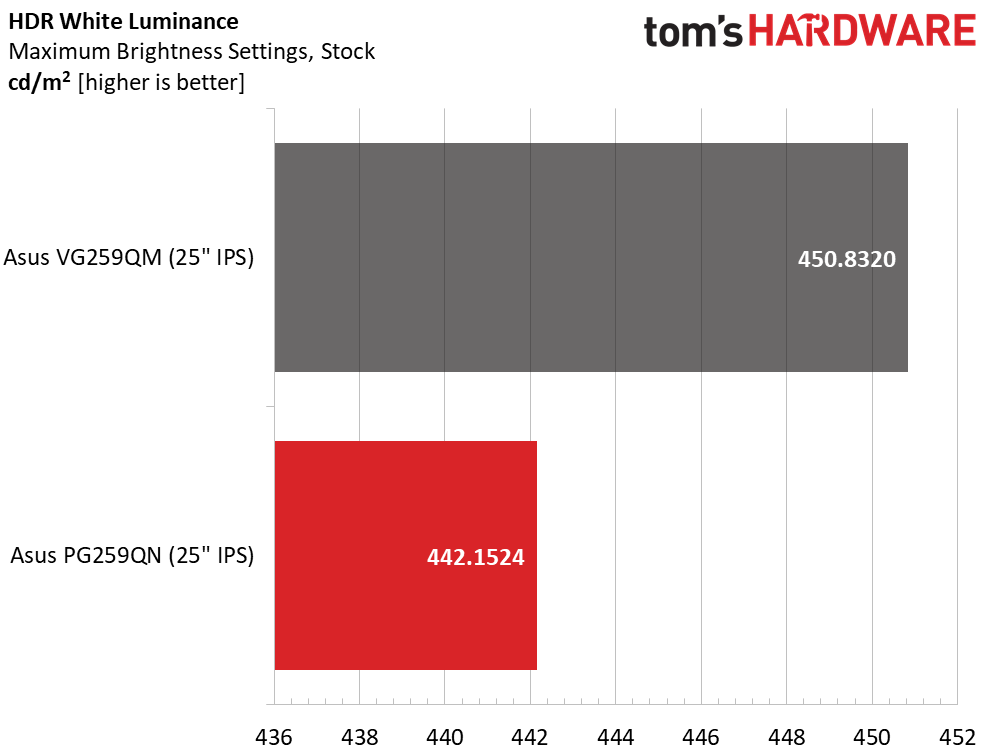
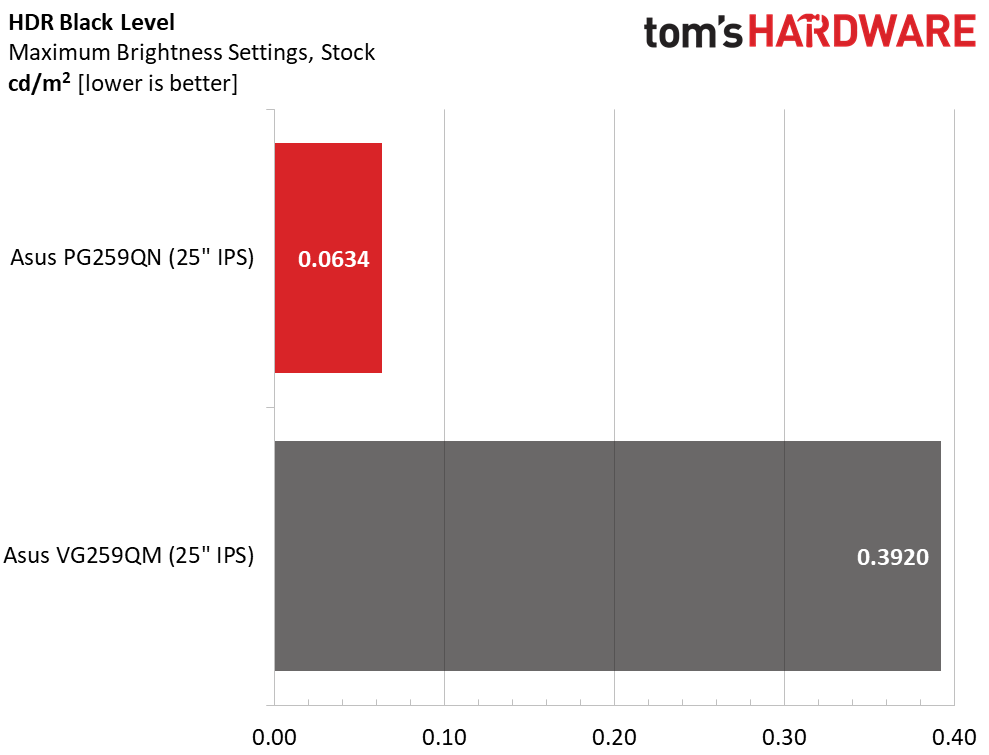
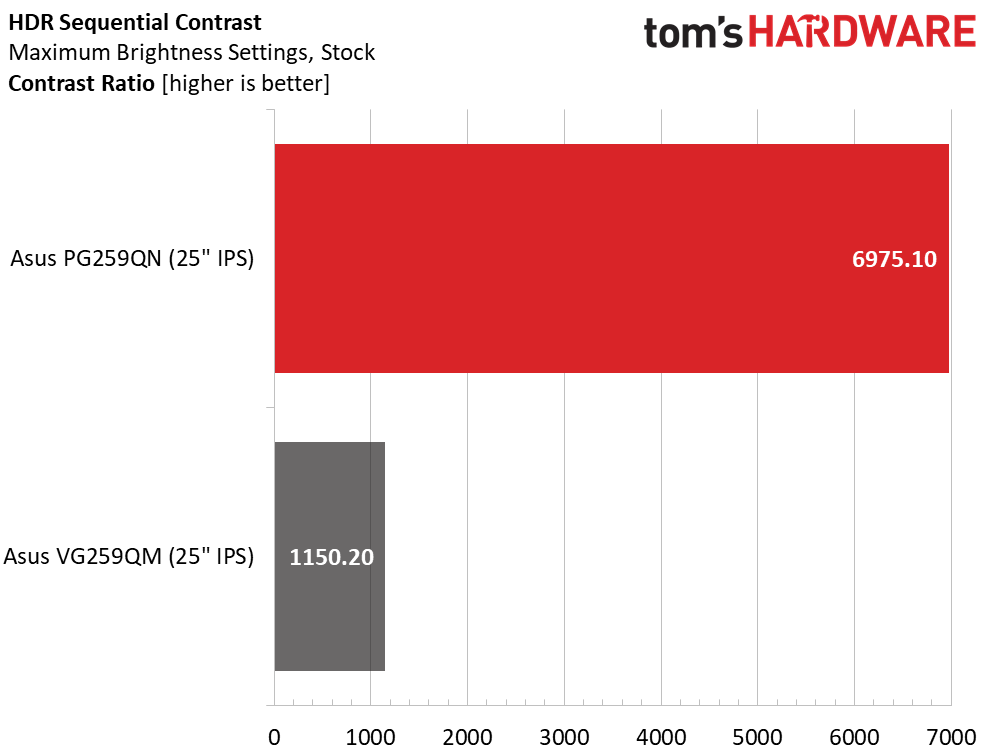
Both Asus monitors put out well over 400 nits in HDR mode, but only the PG259QN engages its variable backlight for HDR. That fact is apparent when comparing black levels and contrast ratios. We can see the difference both in our measurements and with actual content. Though the ROG Swift PG259QN won’t be mistaken for a FALD display, it renders HDR better than most edge-lit monitors. 6,975.1:1 is quite good when compared to the rest of the HDR screens in our database.
Grayscale, EOTF and Color
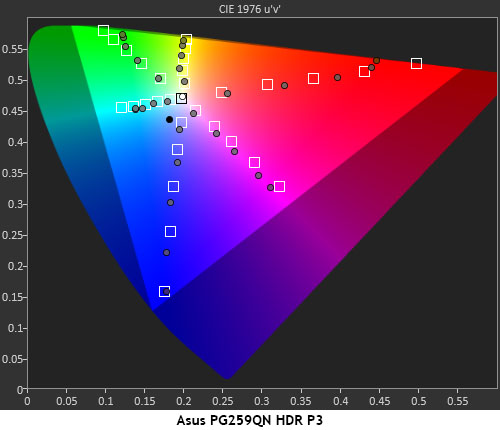
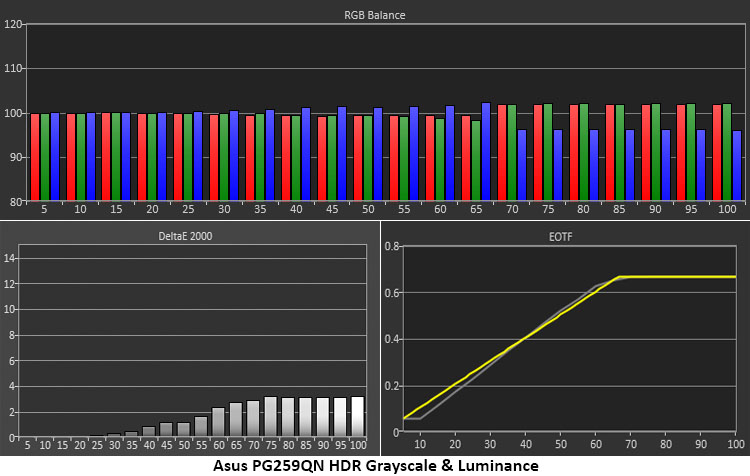
When we first switched the PG259QN into HDR mode, the grayscale pattern looked quite purple. The culprit was our RGB settings for SDR mode, which had carried over into HDR mode. In order to fix this, we simply switched the color temp back to 6500K and removed any visible errors. Above the tone-map transition of 65%, there is a slight warmth that is barely visible. The luminance curve rides the spec closely with 10 and 20% levels looking a little dark. The overall effect, however, is very good.
The PG259QN will not render a larger color gamut in HDR mode; it still covers just 111% of sRGB. The impact of color is, therefore, no different between SDR and HDR. While you get a nice bump in contrast, which is noticeable, color saturation remains the same.
Get Tom's Hardware's best news and in-depth reviews, straight to your inbox.
Current page: HDR Performance
Prev Page Grayscale, Gamma and Color Next Page Viewing Angles, Uniformity, Response and Lag
Christian Eberle is a Contributing Editor for Tom's Hardware US. He's a veteran reviewer of A/V equipment, specializing in monitors. Christian began his obsession with tech when he built his first PC in 1991, a 286 running DOS 3.0 at a blazing 12MHz. In 2006, he undertook training from the Imaging Science Foundation in video calibration and testing and thus started a passion for precise imaging that persists to this day. He is also a professional musician with a degree from the New England Conservatory as a classical bassoonist which he used to good effect as a performer with the West Point Army Band from 1987 to 2013. He enjoys watching movies and listening to high-end audio in his custom-built home theater and can be seen riding trails near his home on a race-ready ICE VTX recumbent trike. Christian enjoys the endless summer in Florida where he lives with his wife and Chihuahua and plays with orchestras around the state.
-
Dayne_87 That's great, but I prefer resolution over frame rate. I have a 1440p Asus ROG 27" with 144hz and G-sync and I'm fine with that for now. If I were going to upgrade for that price I would want it to be at least 1440p 360hz or 4k 144hz or faster and still 27".Reply -
thepersonwithaface45 No idea why companies are focusing on high refresh rates at 1080p. This is the 4k generation, 2k was last gen and we should be getting more choices in the 4k range. Which I'm sure we will, but I don't see anyone paying $700 for a 1080p high refresh rate monitor when for $100 more you can get a 144hz 4k 27" monitor.Reply
Infact, this one is only 24.5"?
What? What is that price for that resolution, you're really just paying for 360hz? -
Jonagold What are all the included latencies in your Absolute Input Lag testing? Could there potentially be mouse button latency included? Also system latency? What are frame-times etc.?Reply -
ashburner This is for competitive gamers and that's it. They are notorious for running high framerate at low resolution. Even at 1080p, almost all effect settings are turned off. It's kinda crap to watch but it works for them. I prefer 2K at 27". I'm at 165hz now but I'm looking at a 4K 27". My 3080 should be in on Tuesday.Reply -
nofanneeded I dont know whats stopping Tomshardware from reviewing LG Oled 4K 55 inch TV for gaming ? it has everything one needs for gaming even Nvidia Gsync.Reply -
mdrejhon Founder of Blur Busters / Inventor of TestUFO here.Reply
I should compliment Toms Hardware for improved mainstream-writing description of how motion blur is reduced -- doubling Hz halves display motion blur, as an alternative to strobing. Yesterday's media used to dismiss high Hz, or was not familiar with the benefits of high Hz.
I would, recommend that TomsHardware do pursuit camera tests with instructions at the forums:
https://forums.blurbusters.com/viewforum.php?f=23(Even an iPhone works as a pursuit camera!) -
mdrejhon Reply
Not necessarily. If you own a 120Hz iPad, you'll notice web browser scrolling is 2x clearer. LCD motion blur halves when LCD Hz doubles. And my 360 Hz monitor has 1/6th web browser scrolling motion blur of a 60 Hz LCD monitor.ashburner said:This is for competitive gamers and that's it.
I have the PG259QN here too, and it's absolutely lovely, especially when combined with the Razer 8000 Hz mouse (I have a prototype here).
4K was a $10,000 frivolity in 2001. Today, 4K is a $299 Walmart special. The mainstreaming of 120 Hz is slowly beginning this decade, with future iPhone/Android devices standardizing at least 120 Hz. But eventually, 240 Hz will be a freebie feature much like Retina screens.
We've almost retina'd out resolution, but we are far away from retina refresh rates. There is already a laboratory engineering path to an 8K 1000Hz display, though that will take many years of progress to reach.
High-Hz isn't just for esports anymore. Though the highest Hz is still expensive and mainly of interest to bigger-budget users. -
CaesarNaykid Reply
I was going to post about your site. My eyes hurt and I cringe every time i see sideways pans in films and I check your site from time to time to see how the race to 1000hz is going. I get why these people like higher resolutions, but even back in the day of the 3DFX Voodoo1 and Voodoo2 SLI I preferred higher framerate over the resolution bumps. I want to see that 1000 hz target hit and this is a positive step that moves the bar even if just a bit towards the goal we need in display technology.mdrejhon said:Founder of Blur Busters / Inventor of TestUFO here.
I should compliment Toms Hardware for improved mainstream-writing description of how motion blur is reduced -- doubling Hz halves display motion blur, as an alternative to strobing. Yesterday's media used to dismiss high Hz, or was not familiar with the benefits of high Hz.
I would, recommend that TomsHardware do pursuit camera tests with instructions at the forums:
https://forums.blurbusters.com/viewforum.php?f=23(Even an iPhone works as a pursuit camera!)